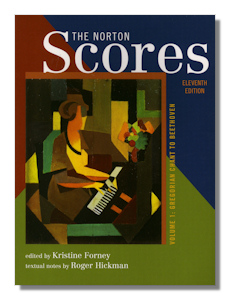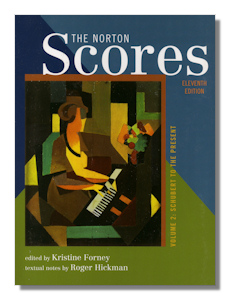
The Internet's Premier Classical Music Source
Related Links
-
Introduction
Acoustics
Ballet
Biographies
Chamber Music
Composers & Composition
Conducting
Criticism & Commentary
Discographies & CD Guides
Fiction
History
Humor
Illustrations & Photos
Instrumental
Lieder
Music Appreciation
Music Education
Music Industry
Music and the Mind
Opera
Orchestration
Reference Works
Scores
Thematic Indices
Theory & Analysis
Vocal Technique
Search Amazon
Recommended Links
Site News
 Book Review
Book Review
The Norton Scores: A Study Anthology

Kristine Forney, ed.; textual notes by Roger Hickman
W.W. Norton 2011 (11th Edition) Volume 1 xvi + 592 pp
ISBN-10: 0393912116
ISBN-13: 978-0393912111
Eight CDs to accompany the scores:
Amazon
- UK
- Germany
- Canada
- France
- Japan
- JPC


W.W. Norton 2011 (11th Edition) Volume 2 xv + 1033 pp
ISBN-10: 0393912124
ISBN-13: 978-0393928907
Printed scores of music, unfamiliar and familiar, add immensely to our appreciation of the music we're listening to. Even with the availability of PDFs online (some of these are of dubious provenance, it has to be said of course), of some inexpensive study scores and of the small scrolling scores that come with some YouTube performances (these, too, must be of questionable origin at times), it can still be a challenge to track down for study the score(s) of music that you really like. So any well-produced, authoritative, representative and otherwise accessible collection of scores is likely to be an advantage to the serious music lover.
Norton has a venerable set, The Norton Scores: A Study Anthology, whose eleventh edition has just appeared. It's in two volumes running to over 1,600 pages yet under 2½ inches thick. But the paper is not Bible-thin. It has a remarkably usable and sturdy feel – even when the books themselves measure only just over 9" by 7". This should tell you that the edition has been very well designed for the user. Handling them in a likely listening context – on your lap or a small table with a CD playing – works very well. True, they're substantial books and weigh as much as you would expect but the perfect binding lies flat enough for proper study as well. They gray "highlighting" (part of Norton's useful annotation apparatus), though, would probably preclude use at concerts.
Of course you cannot assume that any one work to which you were planning to listen is available in this anthology. So how representative is it? How useful are the extracts that almost inevitably comprise such a collection? And how well are they presented? Answers to these three questions suggest that this is a very worthwhile collection to have – especially when you consider its very reasonable price. So if you're looking for a good anthology of scores that will support your listening, there could hardly be a better place to look.
Volume I contains about 70 actual scored movements, numbers or pieces from over three dozen composers from Hildegard von Bingen and tenth century chant to Beethoven. Selective it certainly is: only one item by Palestrina, nothing by Buxtehude but a work by each of Jean-Joseph Mouret and Tieleman Susato. Volume II is almost twice as long and starts with Schubert and ends with Jennifer Higdon; it offers some 70 partial or complete individual pieces from over 50 composers. Nothing by Shostakovich, Elgar or Britten but a small section including Bernstein, Billie Holiday and Dizzy Gillespie. So, Yes, this is a – necessarily – very selective anthology. It has to be. If you're looking to see whether a particular piece or composer is included, consult the Norton site. The aim has been not comprehensiveness reflecting the entirety of Western Art music, obviously; but the advantages of access to complete scores in the cases where anything at all is included. That's why shorter works have often been chosen. You are offered the experience of complementing your appreciation of music by seeing how it was written.
In fact, it's the core genres that have been concentrated on… Baroque Cantata, Romantic Program Music, Twentieth Century National Schools etc. Then representative works used to illustrate those. Indeed, an equally valid way of using (perhaps even a preferred way to use) the anthology is less to see whether a favorite or (recently-)owned recording is included; rather to become familiar with the scores in the anthology and then seek out recordings so as to see "how they work" as a result.
Two sets of matching CDs (eight complete; four selected) are available to this end. There are notes aplenty– tables of clefs and instrument transcriptions and names in English, Italian, German and French etc; a glossary of terms; and index of genres and forms contained in the anthology and various appendices pertaining to the contents and recordings. Perhaps most significantly, the scores are reproduced and annotated in such a way that, for example, the lead melodic line is highlighted; you can more easily follow scores across systems (groups of staves). This annotation is achieved with judicious use of gray and distinct markings. Clear and unambiguous, a lot of work has gone into this. This anthology is no mere collection of otherwise available scores. The idea must be that, as you become competent reading the selective scores and understanding how they relate to the developing musical idioms over a thousand years (the unconventional score styles of Cage and Machover are included), the better equipped you are to tackle many other scores as a result. What's more, each piece has an authoritative, succinct and usually illuminating introductory or illuminating page or two to set it in context and present a distilled analysis of its salient features.
The Norton Scores: A Study Anthology, then, is an appropriately ambitious collection designed to meet a variety of needs – from those of listeners who have perhaps felt intimidated by scores to those who can fully appreciate just how supporting and useful for the music it is to follow a score. The feel of the book (the balance of score data and supplementary and explicative material); its choice of what to include; the changes made in this edition to reflect the contribution of women composers, instrumental techniques from outside Europe and so on; and the extreme value of merely working one's way through recordings of the scores offered and becoming familiar with how they have been written the way they have. These are real and lasting advantages for listeners. For an area as broad as this, almost any undertaking of this sort is a compromise. But it's one at which editor Kristine Forney with the aid of Roger Hickman (responsible for the textual notes) have succeeded admirably.
Copyright © 2011 by Mark Sealey.



















